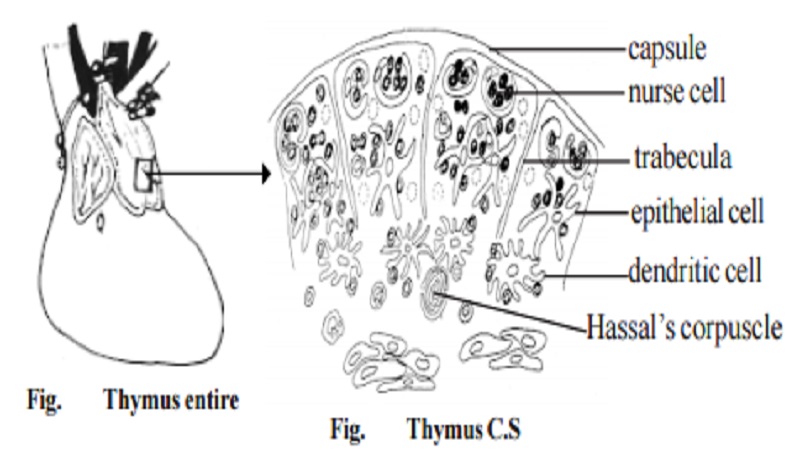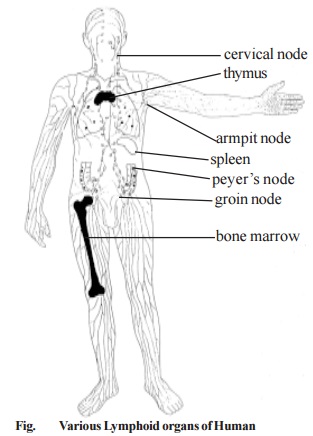Chapter: 11th 12th standard bio zoology Human Body higher secondary school
Primary Lymphoid Organ Thymus

Structure and Functions of the Immune System
The lymphoid system consists of the lymphoid cells (lymphocytes and plasma cells) and lymphoid organs. Based on different roles they perform, lymphoid organs can be classified into central (primary) and peripheral (secondary) lymphoid organs. The central lymphoid organs are lymphoepithelial structures in which the precursor lymphocytes proliferate, develop and acquire immunological capability. In mammals, the bone marrow, the thymus and the bursa of fabricius in birds represent primary lymphoid organs. After acquiring immunocompetence, the lymphocytes migrate along blood and lymph streams, accumulate in the peripheral lymphoid organs and, following antigenic stimulus, effect the appropriate immune response. The spleen, lymph nodes and mucosa - associated lymphoid tissue (MALT) constitute the major peripheral or secondary lymphoid organs. Lymphoidal tissues in the gut ( peyer's patches), appendix, tonsils, salivary glands, tear glands and also the secretion (colostrums) of the lactating breast of the mother also are included in the immune sysytem.

Primary Lymphoid Organ Thymus :
The thymus develops at about the sixth week of gestation. By eighth week, it grows into a compact epithelial structure. Mesenchymal stem cells (precursors of lymphocytes) from the yolk sac, foetal liver and bone marrow reach the thymus and differentiate into the thymic lymphoid cells (thymocytes).
The thymus acquires its characteristic lymphoid appearance by the third month of gestation. It is thus the first organ in all animal species to
become predominantly lymphoid. In human beings, the thymus reaches its maximal size just prior to birth. Thymus continues to grow till about the 12th year. After puberty, it undergoes spontaneous progressive involution, indicating that it functions best only in early life.
The thymus is located just behind the upper part of the heart. It has two lobes surrounded by a fibrous capsule. Septa arising from the capsule divide the gland into lobules which are differentiated into an outer cortex and an inner medulla. The cortex is crowded with actively proliferating small lymphocytes. The medulla consists mainly of epithelial cells and mature lymphocytes amidst which are the hassall's corpuscles, which are whorl-like aggregations of epithelial cells.
The thymus was considered as an organ without any recognized function. But its role in the development of cell mediated immunity has been found recently. The primary function of the thymus is the production of thymic lymphocytes(T cells). It is the major site for T lymphocyte proliferation in the body. However, of the lymphocytes produced, only about one per cent leave the thymus. The rest are destroyed locally by programmed cell death or apoptosis. In the thymus, the lymphocytes acquire new surface antigens (Thy antigens). Lymphocytes produced in the thymus are called 'thymus (T) dependent lymphocytes' or 'T cells'. Unlike, lymphocytes proliferation in the peripheral organs, the function of thymus is independent of antigenic stimulation.
The thymus confers immunological competence on the lymphocytes during their stay in the organ. Prethymic lymphocytes are not immunocompetent. In the thymus they are 'educated' so that they become capable of mounting cell mediated immune response against appropriate antigens. This is effected by hormone-like factors produced by the thymus such as thymulin, thymosin andthymopoietin. The importance of thymus in lymphocyte proliferation and development of CMI is evident from the effects of lymphopenia, and in neonatally thymectomised mice.
T lymphocytes are selectively seeded into certain sites in the peripheral lymphatic tissues. These are found in the white pulp of the spleen, around the periarteriole region, and in the paracortical areas of lymph nodes.
Related Topics